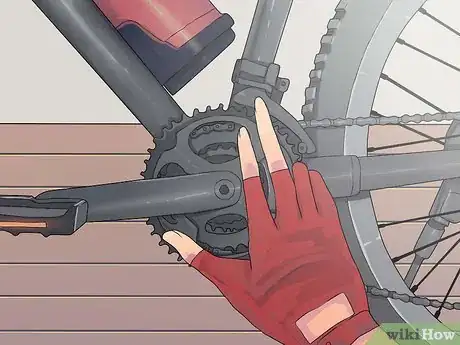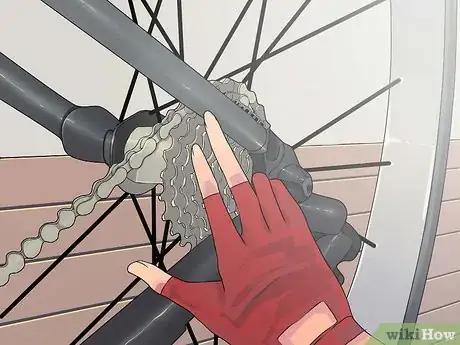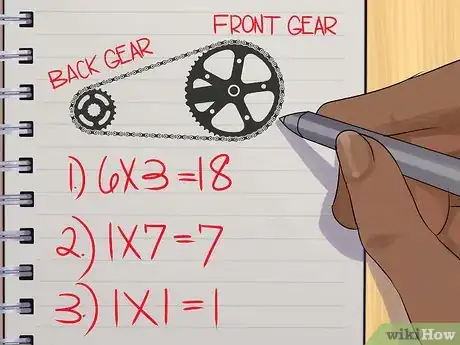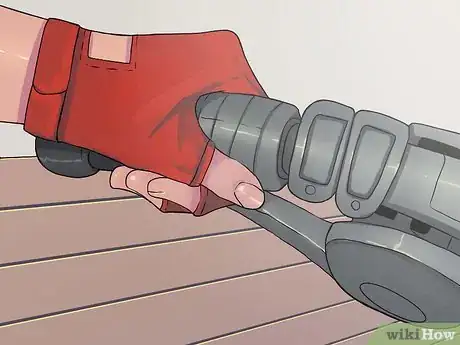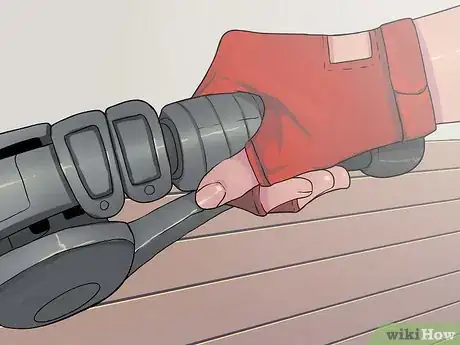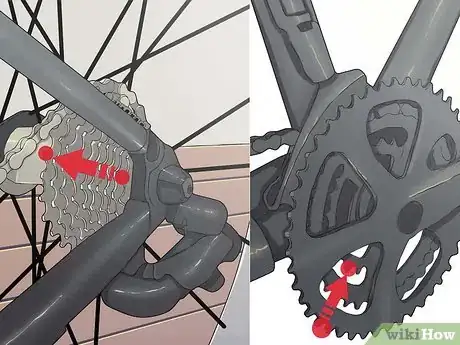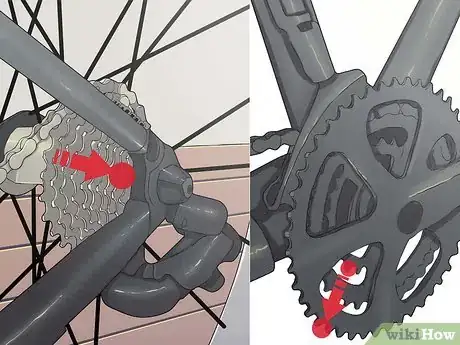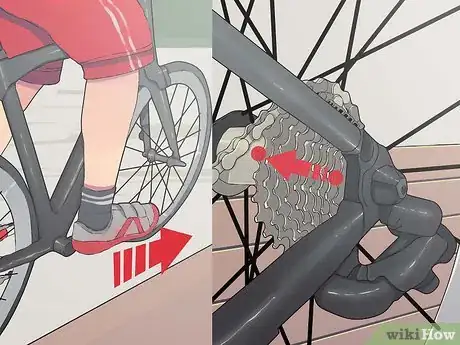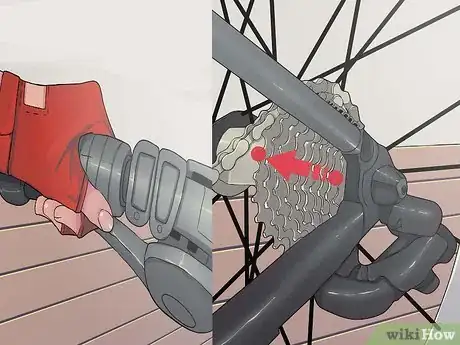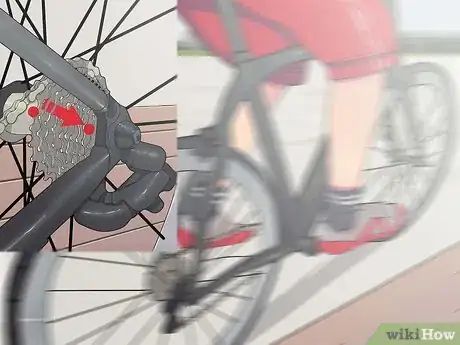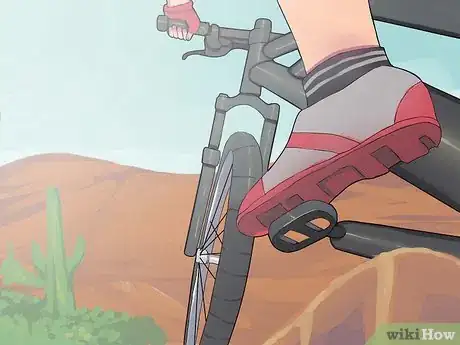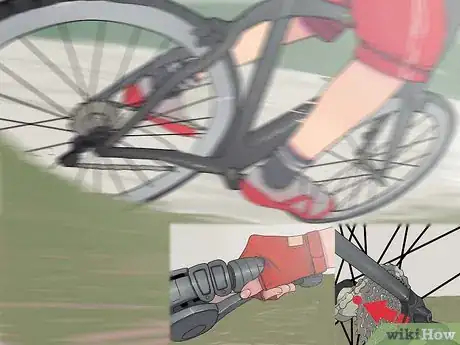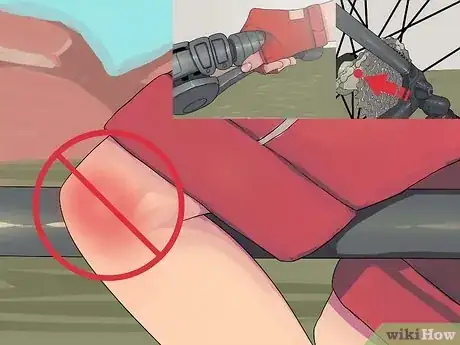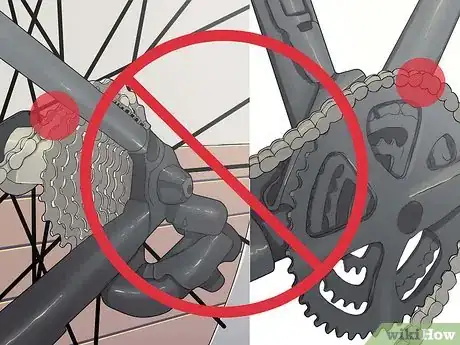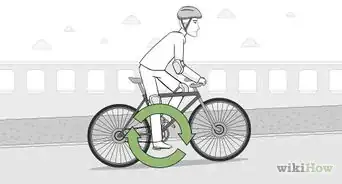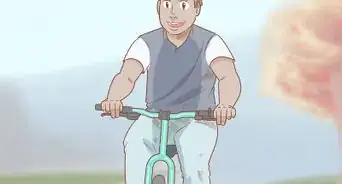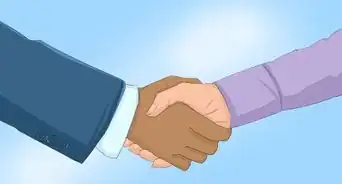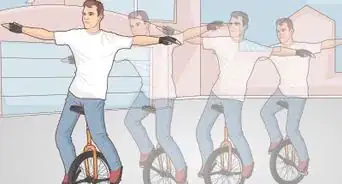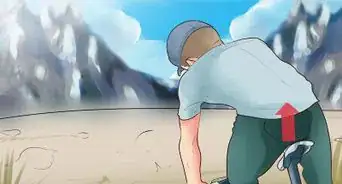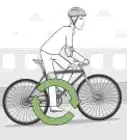This article was co-authored by Ikaika Cox. Ikaika Cox is the Shop Director at the Salt Lake City branch Bicycle Collective in Salt Lake City, Utah. He has been a bike mechanic since 2012, beginning as a volunteer with the Provo Bicycle Collective, and growing and honing his skills as a bicycle mechanic and educator in multiple Bicycle Collective locations over the years. He now leads the Salt Lake City branch of the Bicycle Collective.
wikiHow marks an article as reader-approved once it receives enough positive feedback. This article received 39 testimonials and 100% of readers who voted found it helpful, earning it our reader-approved status.
This article has been viewed 538,449 times.
Tired of pushing your "fixie" up the hill? Getting a bike with gears makes riding more comfortable and efficient whether you're climbing mountains or cruising city streets. Understanding the basics of how gears work can completely change the way you ride your bike, so learn these easy techniques today and start riding with style!
Things You Should Know
- Identify your gears; count the gears at the base of the pedals and on the rear wheel, multiplying them to find how many gears your bike has.
- Shift front gears with your left hand, rear gears with your right; it’s easy to pedal but less efficient on low gears, harder to pedal but more efficient on high ones.
- Start biking on a low gear, gearing up as you build speed; shift gears down when going uphill and back up on level ground or downhill.
Steps
Identifying Your Gears
This section teaches you how to see whether your bike has multiple gears or not and if it does have multiple gears, how many. Click here to skip straight to the part about shifting.
-
1Count the number of gears at the base of the pedals. If you want to learn how to shift gears on your bike, you'll need a bike that has gears in the first place. Luckily, this is easy to check. Start by looking at the pedals. In the center of the pedals, there should be one or more metal rings with teeth on the outside that fit into the chain. These are thefront gears. Count how many gears you see.[1]
- Most bikes will have between one and three front gears.
-
2Count the number of gears on the rear wheel. Now, look at the back wheel. You should see the chain run from the front gears over a different set of rings at the center of the wheel. These are the rear gears.[2] Count how many you see.
- If your bike has gears, there will usually be more rear gears than front gears. Some bikes have ten or more.
Advertisement -
3Multiply the two numbers to find how many gears your bike has. Now, just multiply the number of front gears by the number of rear gears. This tells you the total number of gears your bike has.[3] Some people also call this the number of "speeds."
- For example, if you have three gears in the front and six gears in the back, your bike has 3 × 6 = 18 gears (or "speeds"). If you have one gear in the front and seven gears in the back, your bike has 1 × 7 = 7 gears.
- Some bikes with more than 8 gears may have overlapping gear combinations.
- If your bike only has one gear in the front and one in the rear, it has 1 × 1 = 1 gear. This sort of bike is called a single speed bike. Unfortunately, you can't shift gears on single speed bikes. However, some single speeds may have internal gears in the rear hub.
Shifting Basics
-
1Use your left hand to shift the front gears. Bikes with gears almost always have hand controls on the handlebars to use for shifting. When you use the left-hand controls, a metal loop called a derailleur ("de-railer") shifts the chain from side to side to make it catch on a new front gear. The front gears makes a large shift in your gear ratio. There are a few different mechanisms for shifting that are common on bikes. These include:
- Grip shifters that you work by turning your wrist
- Small levers above or below the handlebars that you work with your thumbs
- Larger levers next to the handbrakes that you work with your fingertips
- More rarely, electronic shifters or levers mounted on the frame of the bike
-
2Use your right hand to shift the rear gears. The rear gears have their own derailleur. Using the right-hand controls will move the rear derailleur side to side, making the chain catch on a new rear gear. The rear gears make smaller adjustments to your gear ratio since they have a smaller difference in tooth count. The rear gears almost always use the same mechanism as the front gears.
- If you can't keep your hand controls straight while you're riding, remember: "right = rear."
-
3Gear down to make your pedaling easier but less powerful. You can change your gears to make riding your bike easier in certain situations. For example, shifting into a "lower" gear lets you pedal quicker and easier, but each pedal won't push you as far. The further inboard the chain is, the easier it will be to pedal. There are two ways to do shift down:
- Shift into a smaller gear in the front.
- Shift into a bigger gear in the back.
-
4Gear up to make your pedaling harder but more powerful. The opposite of shifting down is shifting up into a "higher" gear. These gears make it harder to pedal, but each pedal will push you further and make you go faster. When the chain is farther outboard, it will become more difficult to pedal. There are also two ways to shift up:
- Shift into a bigger gear in the front.
- Shift into a smaller gear in the back.
-
5Practice shifting up and down in a flat area. A good way to get the hang of shifting is to simply start doing it! Go someplace safe and flat (like a park) and start pedaling forward. Try using one of the hand controls to shift up or down. You should hear the chain click or rattle and you'll feel your pedals get either easier or harder to push depending on whether you shifted down or up. Try using both sets of controls to shift in both directions until you get the hang of them.
-
6Only shift while you're pedaling forward. If you're used to a bike that needed you to pedal backward to brake, this can take some time getting used to. The chain can only catch on new gears if it is stretched tight, which requires you to pedal forward. If you shift while you're pedaling backward or not pedaling at all, the chain won't be tight enough to catch. When you start pedaling again, it may rattle around or slip off of the gear. This isn't something you'll want to happen while riding.
Knowing When and How to Shift
-
1Pick a low gear when you start off. The first few pedals you take on your bike are often some of the hardest because you need to go from standing still to cruising speed. Whenever you start riding, shift down to a fairly low gear to make it quicker and easier to get back up to speed.
- You'll also want to do this whenever you come to a complete stop and start pedaling again (like at a red light).
- If you know you're going to stop riding soon, it's a good idea to shift into a low gear so you can get started easier next time. This is especially true if you know you'll have to get out of a tricky spot — like if your home's driveway goes uphill.
-
2Gradually gear up as you build up speed. As you get going faster and faster, you'll find that the lower gears start to feel "too easy" after a while. If you want to keep building up speed, shift up. You'll notice the pedals feel more difficult to push and you'll keep accelerating.
- If you're riding around on moderate terrain (like city streets with a few minor hills), a "middle" gear will usually work well for your default cruising speed. For example, if you're on an 18-speed (three gears in front, six in the rear), using the second gear in the front and the third in the rear should give you a good "middle of the road" option.
-
3Shift down for hills. This is an important skill to learn — without it, you'll be stuck walking your bike up larger hills. It's almost impossible to get up a hill in high gear. However, lower gears let you pump your way up the hill slowly and steadily without too much extra effort.
- You may find it difficult to slowly climb hills in a low gear at first. Since you're moving at a low speed, it's a little more difficult to keep balanced than normal. However, moving slowly means it's easy to drop a foot to the ground if you lose your balance.
-
4Shift up when on fairly level ground and for downhill areas. If you're trying to build up as much speed as possible, using higher gears on this type of terrain is the way to go. Gradually shifting to your highest gears will allow you to keep accelerating at a steady rate until you reach your top speed. Be sure to ride carefully when you're going this fast — it's easier to hurt yourself.
- Being in a high gear is one of the only ways to be able to speed up while you're going downhill. Lower gears won't turn the chain quick enough to keep up with the wheels when you're rolling downhill, making it basically impossible to speed up except from the hill itself.
-
5Shift up carefully to avoid hurting your joints. It can feel satisfying to "pump" your bike into motion in a high gear, but it may be bad for your body in the long run. Straining hard to push a bike that's in too high of gear can put stress on your joints (especially your knees), leading to soreness and even joint problems over time. It's also not as good of exercise for your heart and lungs as pedaling in a lower gear at a steadier pace.[4]
- To be clear, you can use your bike's higher gears, but you should only shift into them gradually after you've already built up speed.
-
6Avoid choosing gears that "crisscross" the chain. As you shift your gears, if you look down at the chain, you may notice that it sometimes points in a slightly diagonal direction. This isn't a problem unless you pick gears that make the chain run at extreme diagonal angles. This can make the chain wear down and break over time and can cause rattling and slippage in the short term. In general, you'll want to avoid having the chain on either the biggest or smallest gears in both the front and in the rear. In other words:
- Don't use the largest front gear with the larger rear gears.
- Don't use the smallest front gear with the smaller rear gears.
Expert Q&A
Did you know you can get expert answers for this article?
Unlock expert answers by supporting wikiHow
-
QuestionHow do I fix the rattling sound when shifting front gears on my bike?
 Ikaika CoxIkaika Cox is the Shop Director at the Salt Lake City branch Bicycle Collective in Salt Lake City, Utah. He has been a bike mechanic since 2012, beginning as a volunteer with the Provo Bicycle Collective, and growing and honing his skills as a bicycle mechanic and educator in multiple Bicycle Collective locations over the years. He now leads the Salt Lake City branch of the Bicycle Collective.
Ikaika CoxIkaika Cox is the Shop Director at the Salt Lake City branch Bicycle Collective in Salt Lake City, Utah. He has been a bike mechanic since 2012, beginning as a volunteer with the Provo Bicycle Collective, and growing and honing his skills as a bicycle mechanic and educator in multiple Bicycle Collective locations over the years. He now leads the Salt Lake City branch of the Bicycle Collective.
Bicycle Mechanic Sometimes the front shifter can be out of adjustment. You can make small adjustments to your overall cable tension with the barrel adjuster on the shifter. Other times, your left shifter may have a “trim” position to move the cage over. Experiment with different things to identify what will work for your bike.
Sometimes the front shifter can be out of adjustment. You can make small adjustments to your overall cable tension with the barrel adjuster on the shifter. Other times, your left shifter may have a “trim” position to move the cage over. Experiment with different things to identify what will work for your bike. -
QuestionCan I shift both the front and the back gears at the same time on a bike?
 Ikaika CoxIkaika Cox is the Shop Director at the Salt Lake City branch Bicycle Collective in Salt Lake City, Utah. He has been a bike mechanic since 2012, beginning as a volunteer with the Provo Bicycle Collective, and growing and honing his skills as a bicycle mechanic and educator in multiple Bicycle Collective locations over the years. He now leads the Salt Lake City branch of the Bicycle Collective.
Ikaika CoxIkaika Cox is the Shop Director at the Salt Lake City branch Bicycle Collective in Salt Lake City, Utah. He has been a bike mechanic since 2012, beginning as a volunteer with the Provo Bicycle Collective, and growing and honing his skills as a bicycle mechanic and educator in multiple Bicycle Collective locations over the years. He now leads the Salt Lake City branch of the Bicycle Collective.
Bicycle Mechanic
-
QuestionDoes this mean that the left and the right hand both need to be on 1 for lowest?
 Community AnswerYes, both low numbers mean low gears. Although the lowest gear is not always equal to the smallest gear in size. A low gear will mean a small gear in size at the front and a large gear at the back and a high gear will be inverted to that.
Community AnswerYes, both low numbers mean low gears. Although the lowest gear is not always equal to the smallest gear in size. A low gear will mean a small gear in size at the front and a large gear at the back and a high gear will be inverted to that.
References
About This Article
Knowing when and how to shift into the right gear can make riding a bike much more comfortable and efficient. To shift the front gears on your bike, use the lever or grip shifter on the left handlebar. The shifter for the rear gears is located on the right handlebar. To make your pedaling easier but less powerful, shift to a smaller gear in front and a bigger gear in back. This is called shifting into a lower gear. If you need to increase your pedaling power, do the opposite and shift into a higher gear: shift to a larger gear in front and a smaller one in back. Practice changing gears while pedaling on a flat surface, and always shift while you are pedaling forward. In general, it’s good to start in a low gear when you begin a bike ride and then shift up to a higher gear as you start to pick up speed. Middle gears are good on relatively flat terrain and minor hills, while low gears work best for bigger hills. If you’re heading downhill, shift into high gear. Avoid shifting into high gear when it’s not necessary since the added effort of pedaling in high gear can put extra strain on your joints. Always shift gradually into higher gears after you’ve built up speed instead of making a sudden jump from a low gear to a high one. To learn how to avoid “crisscrossing” the chain on your bike, keep reading!
